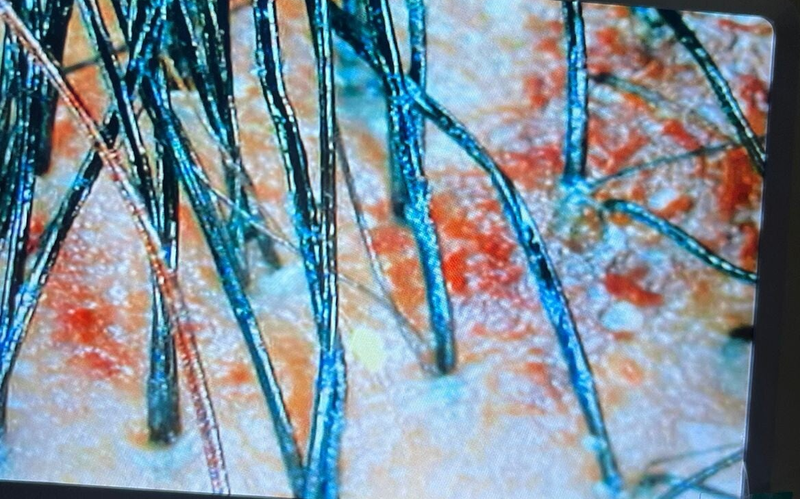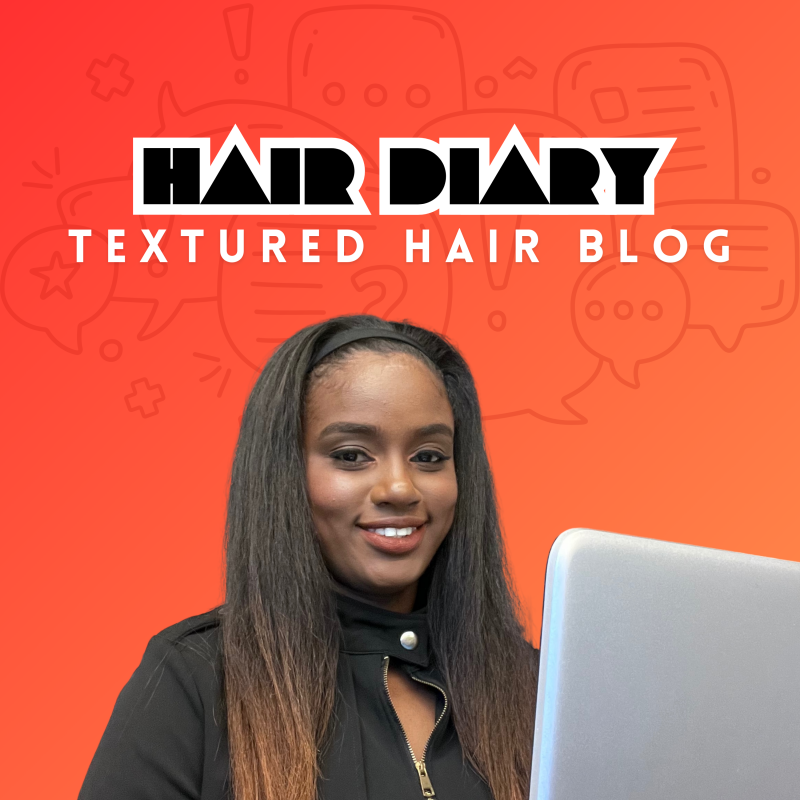Part 1 of a 3-part series on Curl Science.
Hair (Dear) Diary,
In the quest for perfect hair, many people overlook a critical aspect that lies beyond shampoos, conditioners, and styling tools: the hair microbiome. This intricate, microscopic ecosystem plays a vital role in the overall health and appearance of your hair, especially textured hair. Understanding this hidden world can revolutionize your hair care routine, paving the way for healthier and more resilient strands.

The Microbiome Ecosystem
Your hair microbiome consists of an array of microorganisms, including bacteria, fungi, and yeasts, that reside on the scalp and hair shafts. In biology class, I had to accept my fate that I am simply a host of many tiny, invisible organisms. They work collectively to maintain a balanced environment that supports my health and wellbeing, they are my tenants. They can however turn the house upside down, if they don't have checks and balances.
The scalp microbiome is distinct from the hair shaft microbiome, each with its unique composition and functions. For textured hair, the microbiome tends to show unique differences. Textured hair, characterized by its waves, coils, curls, and kinks, creates a different habitat compared to straight hair, which can affect the type and concentration of microorganisms present at any given time.
Functions of the Hair Microbiome
"The tenants" serve many purposes, they are not idly living on your body. They affect your scalp's oil production, hair growth, a balanced environment and more. Let's dive into the main functions the microorganisms affect.
-
One of their crucial roles is protecting against pathogens. The good bacteria on your scalp act like a barrier, preventing harmful microbes from causing infections and inflammation.
-
They also help regulate sebum production. Too much sebum leads to oily hair and scalp issues like dandruff, while too little results in dryness and breakage. The microbiome helps strike a balance, ensuring your scalp produces the right amount of natural oils.
-
The hair growth cycle is another area where the microbiome exerts its influence. Certain bacteria and fungi can promote or inhibit hair growth by interacting with hair follicles. A well-balanced microbiome can foster an environment conducive to robust hair growth.
-
Not to be overlooked is its impact on hair texture and appearance. The right balance of microorganisms can enhance shine, reduce frizz, and make your textured hair more manageable.
Factors Affecting the Hair Microbiome
You may be thinking, "How can I make them work for me?"
Various factors contribute to the state of your hair microbiome. Genetics play an inherent role; you might be naturally predisposed to a particular microbial balance. Environmental factors, such as air quality, humidity, and exposure to pollutants, also influence the microbial ecosystem on your scalp and hair. But perhaps the two most significant factors are your Hair Care Routine and Diet/Nutrition. Over washing, using harsh chemicals, or neglecting proper conditioning can disrupt the microbiome, leading to imbalances. While for diet and nutrition consuming a balanced diet can promote a healthy microbial environment in your gut that supports your scalp. Poor dietary choices can do the inverse, invite imbalances that compromise your hair’s integrity.
Balance is the common goal of all these factors, so let's explore what the imbalance can look like for a better understanding.
Common Microbiome Imbalances in Textured Hair
Several conditions arise from an imbalanced hair microbiome, many of which are particularly common in textured hair.
Dandruff and seborrheic dermatitis, for instance, result from an overgrowth of the Malassezia fungus, leading to flakiness and itching. This can be caused by an imbalance in diet. Consuming too much sugar (over) feeds the yeast on your scalps surface. Another action that affects this overgrowth is infrequent cleansing of your scalp aka too long of a gap in between your shampoos.
For textured hair our thickness and density play a role. When we use the air-drying method specifically, due to the length of time it can take for the scalp to fully dry, the yeast can begin reproduction. As the perfect combination for this is the heat from our scalp and moisture (water). Simply put, we have just undone our clarifying efforts by leaving our scalp waterlogged. To alleviate this challenge, we must ensure the scalp is 100% dried after a shampoo routine.
Scalp psoriasis, characterized by red patches and silver scales, can also stem from microbial imbalances. Folliculitis, an infection of the hair follicles, is another issue that can wreak havoc on your scalp and hair. Diet, genetics and hair care routine are the contributing factors at play, genetics being the major one. A dermatologist once asked me if either of my parents had allergies, my mother is allergic to shellfish. He said that gene mutation in me, is what has me prone to skin disorders.
A notable mention based on my observation as a textured hairstylist, is the length of time we leave protective styles in our hair. Particularly sew-ins. Though debatable, I have seen women with healthy scalps cultivate the perfect environment for bacterial overgrowth by leaving their sew-ins in longer than the recommended 4 weeks. Practicing this repeatedly have caused fungi to thrive on their scalp's surface changing the microbiome on their scalp entirely. This could have been avoided.

Nurturing a Healthy Hair Microbiome
Maintaining a healthy hair microbiome starts with a proper shampoo routine. Too frequent shampoo can dehydrate your scalp while insufficient washing can lead to buildup. Balance comes based on your texture AND your lifestyle. I suggest partnering with a textured hair stylist to find your ideal routine, however these are what we consider.
Cleansing and Moisturizing are equally important as textured hair tends to be drier on the strands due to its curl pattern and oily at the root. Our unique challenge is cultivating a routine that allows the natural oils to travel down the shaft to hydrate the entire length of our hair. Confirmation of my approach has been revealed in recent products brought to market. With a focus on scalp cleansing, pH balancing, and strand moisturizing it's the holy grail of nourishment for Textured Hair. This is how we can support a healthy microbial environment for our hair and scalp.
Another key factor is "giving your scalp air". This benefits the microbiome by allowing homeostasis to naturally occur. Think 2-week protective hairstyles for naturals allowing your scalp to breathe and leaving your relaxed hair out for 2-week intervals between sew-in installs.
Diet and Lifestyle for a Healthy Hair Microbiome
Your diet and lifestyle choices significantly impact your hair microbiome. Nutrient-rich foods like fruits, vegetables, lean proteins, and whole grains supply essential vitamins and minerals that promote robust microbial health. Omega-3 fatty acids, found in fish and flaxseed, can help reduce inflammation, benefiting both the scalp and hair.
I've recently started incorporating naturally occurring probiotics into my diet, to support my gut health and overall wellbeing. Probiotics introduce beneficial bacteria, while prebiotics provide food for these good microbes, creating a favorable environment for them to thrive.
Hydration cannot be overstated. Drinking plenty of water (H2O) and eating fruits (our H3O2) supports this consistent need. Hydrated skin and scalp provide a conducive environment for beneficial microbes, enhancing the overall health and appearance of your textured hair.
Lifestyle activities like meditation, a healthy sleep routine and exercise support our wellbeing. We do however face a unique Textured Hair challenge with the sweat production as a byproduct of exercise. It poofs our hair and also changes the microbial environment. The bacteria love sweat, so we have to ensure we dry our scalp before locking it away for the night under a scarf or a bonnet. A key indicator of the change is the scent of our hair when we do our morning take down. That signifies it's time to shampoo.
The Future of Microbiome Research in Textured Hair Care
The field of microbiome research holds immense promise for the future of hair care, I am particularly interested in what it will bring to light for textured hair, as our experiences are unique.
- Personalized hair care solutions based on microbiome analysis could soon become a reality. By understanding your unique microbial makeup, hair care products and routines can be tailored to meet your specific needs, ensuring optimal results.
- I look forward to the development of targeted probiotic treatments that can provide solutions for various scalp conditions. Moreover, manipulating the microbiome holds potential for treating hair disorders. By introducing specific beneficial microorganisms or adjusting the microbial environment, it may be possible to cure conditions like seborrheic dermatitis, psoriasis, and even hair loss.
In Conclusion, the hair microbiome is a fascinating, often overlooked component of hair health, particularly for textured hair. From protecting against pathogens to influencing hair growth and appearance, these microorganisms play a crucial role in maintaining balanced, healthy, and beautiful hair. Embracing microbiome-friendly hair care practices, from proper cleansing and conditioning to incorporating probiotic into your diet, can transform the health of your textured hair. Our "tenants" can help if we provide a healthy home.
Armed with this knowledge, it's time to take a mindful approach to your hair care routine. Consider the microbiome, and you'll be well on your way to achieving the healthy, resilient, and stunning textured hair you’ve always desired. I'd love to have a hair consult with you to discuss your uniqueness. Let's chat!
Yours Wholeheartedly,
ShimiliaB
Add comment
Comments